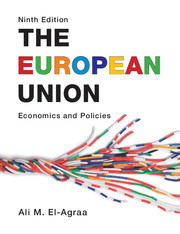Book contents
- Frontmatter
- Contents
- Figures
- Tables
- Boxes
- Contributors
- Preface
- A reader’s guide
- Abbreviations
- 1 General introduction
- Part I EU history, institutions and legal dimension
- Part II EU market integration
- 6 The theory of economic integration
- 7 The economics of the single market
- 8 Factor mobility
- 9 Measuring the economic impact of European integration
- Part III EU monetary integration
- Part IV The single European market
- Part V EU budget and structural policies
- Part VI EU external relations
- Part VII The future of the EU
- Bibliography
- Author Index
- Index
- References
9 - Measuring the economic impact of European integration
from Part II - EU market integration
- Frontmatter
- Contents
- Figures
- Tables
- Boxes
- Contributors
- Preface
- A reader’s guide
- Abbreviations
- 1 General introduction
- Part I EU history, institutions and legal dimension
- Part II EU market integration
- 6 The theory of economic integration
- 7 The economics of the single market
- 8 Factor mobility
- 9 Measuring the economic impact of European integration
- Part III EU monetary integration
- Part IV The single European market
- Part V EU budget and structural policies
- Part VI EU external relations
- Part VII The future of the EU
- Bibliography
- Author Index
- Index
- References
Summary
Introduction
This may not seem to be the appropriate place in the book to discuss the impact of European integration on the economy of the EU and member states (MSs), since economic and monetary union (EMU; Chapters 10–12), as well as all EU policy areas, are yet to come. However, the overall economic aims of the EU have already been stated (Chapter 2), the theoretical considerations identifying what needs measurement delineated (Chapter 6), and the changes expected from the single European market (SEM) pinpointed (Chapter 7). Also, each policy area is unique, requiring its own analytical approach, hence its specific measurement technique, so all cannot be lumped together to be tackled in unison. Of course, there are close theoretical associations between EMU, tax harmonization (Chapter 15) and the EU budget (Chapter 19), but even these have their own peculiarities, so they need separate treatment.
The issues raised in the mentioned chapters inform us of what needs measuring as a consequence of EU formation: the short-term resource reallocation effects – that is, trade creation (TC) and trade diversion (TD); changes in the terms of trade (t/t); changes in rates of economic growth and welfare; and the longer-term dynamic effects. This chapter briefly deals with each of these, but several aspects are covered in other chapters so will only be touched on. The chapter finishes with conclusions.
- Type
- Chapter
- Information
- The European UnionEconomics and Policies, pp. 126 - 144Publisher: Cambridge University PressPrint publication year: 2011



